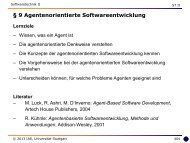Grundlagen FlexRay - Institut für Automatisierungs- und ...
Grundlagen FlexRay - Institut für Automatisierungs- und ...
Grundlagen FlexRay - Institut für Automatisierungs- und ...
You also want an ePaper? Increase the reach of your titles
YUMPU automatically turns print PDFs into web optimized ePapers that Google loves.
<strong>Gr<strong>und</strong>lagen</strong> <strong>FlexRay</strong> BasicsV 1.1 28<br />
As a security measure, the Action Offset Point (APO) in each slot has been introduced (see<br />
Figure 2.24). With the help of the APO, it is possible to compensate slight timing differences<br />
between ECUs, and to compensate for bus delay, without interfering with the global<br />
synchronization process.<br />
Figure 2.24 Action Point and Action Point Offset [VeSc11]<br />
The APO is derived from the actual Action Point (AP) of the sender. The received frame can<br />
be shifted in between the start and the end of a slot. This guarantees, that all ECUs receive a<br />
message in the correct slot.<br />
Figure 2.25 Static Segment Frame [FRPS05]<br />
While transmitting and receiving, the Bus Driver has to switch between these two modes,<br />
because the <strong>FlexRay</strong> bus is used bi-directional. Therefore, for activating the Bus Driver after<br />
the Action Pont, a Transmission Start Sequence (TSS) is used. The length of the TSS varies<br />
between 3 and 15 bit, depending on the number of Bus Drivers connected to the channel,<br />
Bäurle 12.10.2012
















